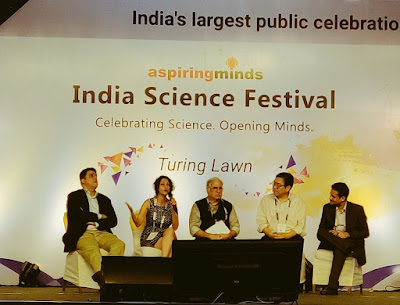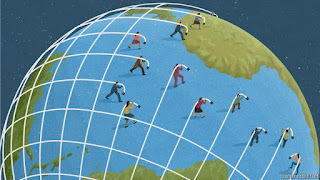General Electric Panel on Cutting through the hype (Helsinki WCSJ 2013)
 | ||
General Electric Panel Helsinki Finland June 26 2013 (WCSJ)
|
Simply put, there is no escaping the conversation of social media infiltration into all corporate spheres, including that of the energy world. In a forum such as this where science journalists are confronted time and again with the hype on citizen scientists and amateur journalism as somehow more authentic, there is need to talk about the impact of Web 2.0 on communicating science to the public. Today, science journalists are expected to be more flexible in their expertise, be able to move seamlessly through multimedia platforms and transform their language constantly to suit the needs of the diverse audience out there in the Twitterverse to the Blogosphere.
There is concern about reductionism and popularization of science and the compromise of the integrity of the science journalist as s/he views this as selling out to mass appeal. But as we see this play out, it is hardly a choice of amateur versus the expert but rather we need to view this new communicative landscape in its spectrum of pitfalls and opportunities. For instance, at the conference there was much talk about data checking departments being shut down due to budget cuts and the genuine concern by journalists on making sure their reports were cross-checked for errors and misinformation. Here, crowdsourcing can come in handy where citizens volunteer to do that for experts and lend to the vigor of the article rather than diminish it. (This is not to advocate for it replacing professional data checking but given the financial crisis within the field of journalism, this provides some solace to journalists looking to maintain their quality of reporting).
Also, when citizens take an interest in science through participation, this also increases the audience for science journalists. When there is personal involvement in the making of science news, this is bound to generate an interest in consuming such news. Also, science journalists need to view these amateurs as possible mavens, disseminating critical science through the numerous channels of mass media, framing it in numerous ways beyond that which is institutionally endorsed by the state and corporate entities. While by no means am I an uncritical enthusiast for the much talked about wisdom of the crowds and collective intelligence phenomena, I do see the potential in amateur involvement. What would be worse is public indifference to science where decisions are made through primarily emotion and not understanding of the ramifications of science in our daily lives.
What struck me was how much in common the art market has with the world of science. Currently, one of my research projects entails gauging the impact of social media on the traditional gatekeepers of the art world such as museums, galleries and art critics. Much like science journalists, art experts are far from redundant in this information deluge. Experts are very much entrenched to guide audiences through this maze of data online but what has changed is the nature of expertise in their communicating and networking abilities that requires re-addressing. Basically, the role of the science journalist as the primary interface in the golden triangle of the scientist, state and the industry is over. Today, there are multiple intermediaries due to the affordances of new media and the changing appetite of the public for more accessible science. There have been a number of studies that demonstrate that the public accesses their science and technology information primarily through the medium of entertainment such as the television (NSB 2008; Pew Research Center on People and the Press 2008). Social media platforms come second as a source for investigating more on specific science issues such as climate change.
Of course, this comes with a whole host of problems including the promotion of pseudoscience and the hijacking of the Google algorithm by concerted parties. That said, if we are to Google water and nuclear energy debates, what we get are a range of results that are not all corporate-oriented. For instance, the search results for water debates are biased toward conversations around water conservation in Australia and New Zealand while the nuclear energy debates seem to be driven by a non profit 'Do Something. Org.' In other words, it isn't necessarily the commercialization of algorithms that has pervaded as internet pessimists have predicted but rather a cat and mouse game between corporate, non-profit and other special interest groups that fight to dictate the search for science issues, shaping how the public constructs and processes them as fact.
Contrary to popular belief, this emphasis on public engagement cannot be credited solely to social media. In fact, if we are to look at public policy on science dissemination, well in the 1980s, from the UK to the Netherlands, there was a concerted effort to make science public and promote what is called as 'deliberative democracy.' In 1985, the Royal Society in London issued a report on The Public Understanding of Science, where it was the moral responsibility of the state to make transparent its expenditure by explaining science investments in layman terms and connect it to the everyday life of citizens. Or take for instance the Broad Societal Debate around Energy Policy (BMD) in the Netherlands in the early 1980s. The Dutch Parliament was instrumental in organizing broad societal debates pre-Facebook era on a range of science agendas including cloning, GM-food and xeno-transplantation.
This historical rootedness can be found even in the hype around big data. There is an overwhelming feeling that science journalism has been overtaken by the algorithmic mastermind that swerves conversation and factoids in the digital landscape of reporting. While undoubtedly the scale at which data is collated is unprecedented, it is hardly new. Citizens have been contributing information about their lifestyles, preferences and opinions through conventional media and the state and corporate entities have been gathering them in strategic ways to market and personalize articles of interest and frame science agendas that makes it more palatable to the public. Granted, big data is more sweeping and thereby gives us the impression of being more representative of the public. However, it is still the amassing of data from those within the system which leaves a large percentage of the global public that are undocumented and outside the radar to not be considered. Last but not the least, the role of science journalists is to convert this data into a narrative, to guide conversations on energy debates through their story telling. They need to use big data as a starting point of critique and analysis rather than factoids that create a grand narrative of critical science that pertains to our daily lives.








Comments
Post a Comment